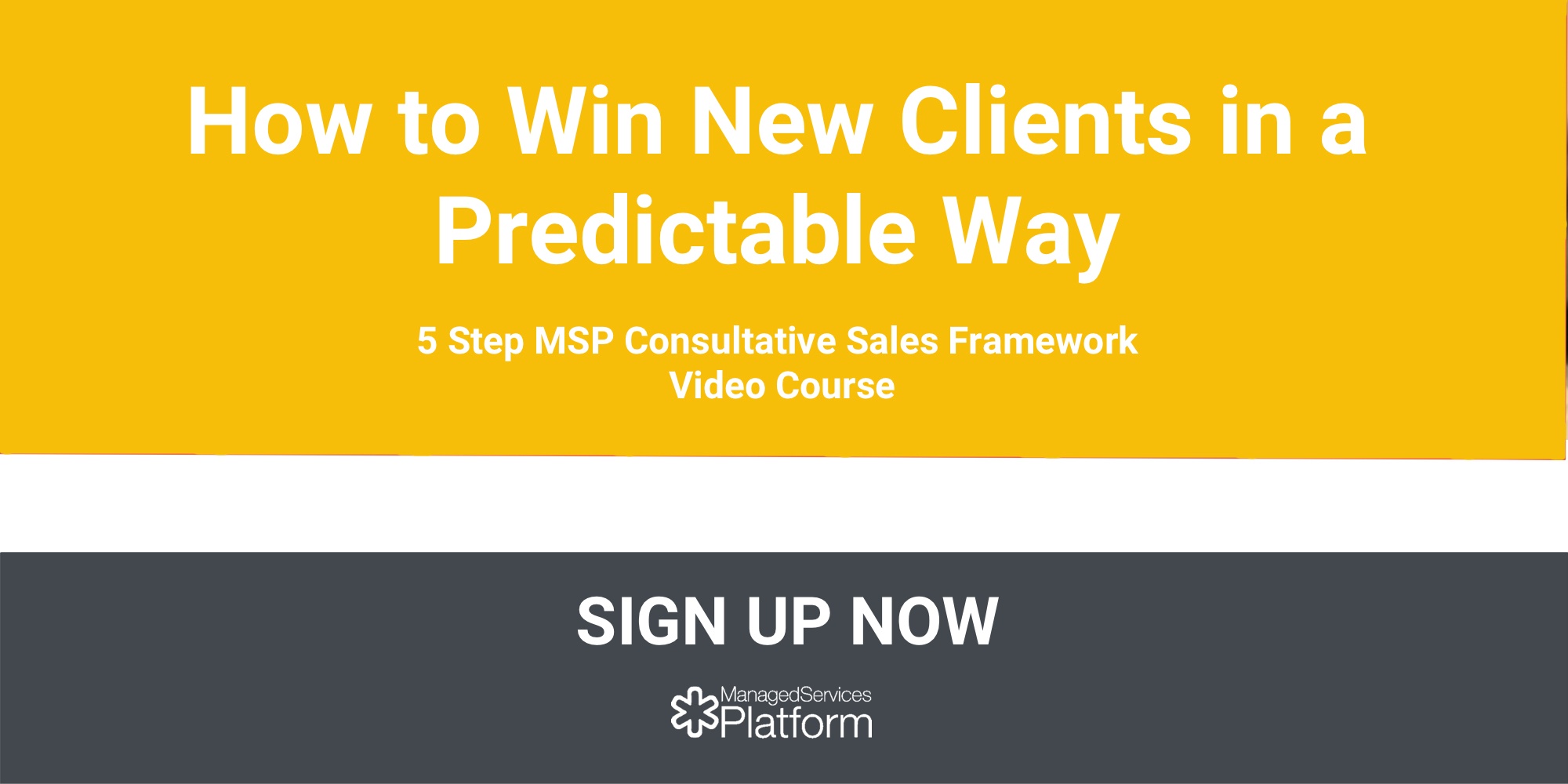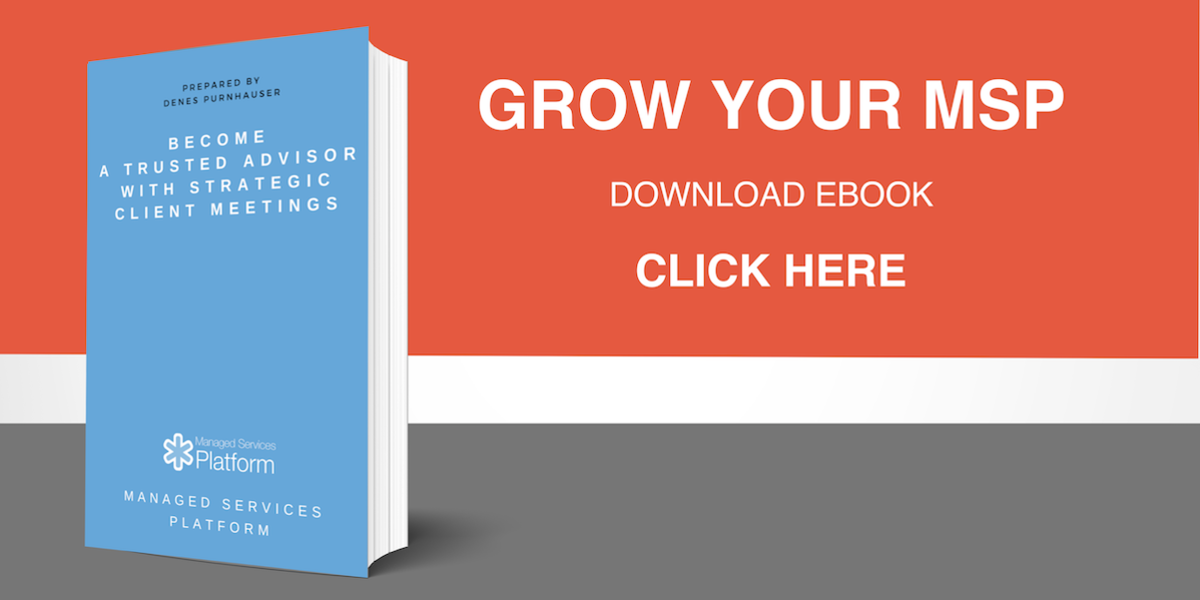PitchIT Volume 1
By Adam Walter on June 27 2022
Spotify: https://spoti.fi/3AyHCUd
Youtube: https://youtu.be/cZnUQXv1mPw
Get ready to share your innovation with the world. Whether your solution solves a need in IT, finance, business operations or sales, it is up to you to make sure that your business has the resources and structure for you, your colleagues and your clients to get the job done.
This week we have a great guest speaker, Sean Lardo of ConnectWise. With so much ground to cover, we have a two-part podcast coming your way!
So many of us have found ourselves in a time when we did not have the right processes or technologies to simplify workloads and make scaleable business models. When this happens, everyone suffers. We may not always have the answers or solutions to ensure that these processes are in place. Sometimes, the right answer is, “I don’t know.” Take this opportunity to learn, make connections in your industry and get excited about the possibilities on the horizon. Teach this to your colleagues and employees. They may not have all the knowledge, but encourage them to ask questions. Take the time to educate them about your industry and get them excited about your mission and the work you do. When people are passionate about your vision, they become a sponge to soak up knowledge! Talk to people in a language they can understand. Not everyone knows the lingo or work of your industry. Get on their level, and they’ll rise to the occasion.
We focus on conversations, not presentations. Sure, a presentation can be helpful and informative. But how do people really connect and retain what they’ve learned? How many relationships have you built solely on a slide show? Probably none. That’s why it is so important to add that personal touch by taking the time to talk with people. Open communication and conversations with your clients and colleagues make you a better leader and innovator. There’s a lot of passion in building relationships. Bring that passion to your team and your business!
When bringing your vision to fruition, it can feel a bit overwhelming. There are a lot of things to think about because we all know that a well-laid plan means nothing if you don’t have or provide the tools to execute your ideas. For example, if you’ve created the best firewall that’s ever been made, it will not go anywhere without a great sales team to bring in new clients and a crew of staff to keep your operations running smoothly. Sometimes looking at the big picture is not the best idea. So many things to do. So little time to do it. One of the best ways to deal with a huge undertaking is to take a note from the great Sherlock Holmes - keep a clean attic. Clear your head, cut out the unnecessary noise of information and make room in your brain for the context that helps you connect the dots and build. Remember, there’s success to be had when you are the architect with a vision instead of a micromanager who loses sight.
Enjoy the ride! The world is ready and eager for your innovation.
Opportunity Preparation and Failure
By Adam Walter on June 6 2022
Apple Podcasts: https://apple.co/2NHRRDl
Spotify: https://spoti.fi/3AyHCUd
Youtube: https://youtu.be/1NypPGLGvW0
As a business owner, you probably spend a lot of time planning. Generally, your plans probably don’t happen exactly how you thought they would—but, when they do then all the time you spend prepping is worth it. That’s exactly what this week’s episode is all about. Opportunities, preparation and failure.
Engineers have a more difficult time getting used to the concept of strategy and having a plan for the future. If there is a piece of technology that is broken, there are steps to take in order to fix it. The fix is also right there in front of you as is the solution. Once you fix the problem then you close the ticket and call it accomplished and feel the satisfaction of starting a solving a problem quickly and seeing results instantly. The effects of your efforts are visible.
For businesses, it’s not the same. Business owners have to spend time coming up with a general idea of where they want to be in the future and figure out how to get there over time.
This prep work is super important. If you have no aim for your business, then what are you really trying to accomplish? Wanting to make money is not a good enough reason to be in business. You have to have a strategy for how you will actually be successful.
It all comes down to making a plan, working that plan and then reviewing that plan. First, you need to access what the goals are for your company. What are you currently doing and what do you hope to be doing in 1, 2 or even 5 years? Have a vision for the future of your business. Then, get everyone in your company on board. If only one person knows about what your goals are, then they will not be achieved. When everyone is on the same page, start looking at current and future opportunities and match up those that will line up with your vision. Be careful not to spread yourself too thin. You can’t and shouldn’t say yes to everything just because it’s available. That will set you up for failure. Be okay with saying no to things.
If saying no is really hard for you, then think through this process any time you are considering an opportunity. Look at your goals and who your company is. Does this opportunity match who you are and will it help you get to where you want to be? If you answer no to either of these questions or don’t know, then it’s safe to say no to that opportunity.
The last piece of prepping your business is learning from failures. There are going to be opportunities that you take that will not pan out. There are going to be situations that you didn’t prepare for or prepared incorrectly. Do not beat yourself up or get frustrated with your business plan. Look at these things and learn what you could have done differently. Adjust your goals. Move forward knowing that you will most likely make that same mistake again.
To sum everything up, Look at the opportunities ahead of you, match those up with the vision and goals for your company and then make preparations for those goals. And just know that you will never get to a point where all your goals have been met and you’re done. You’ll always be adjusting and changing as you grow into a better version of your business.
MSP Culture
By Adam Walter on May 31 2022
Apple Podcasts: https://apple.co/2NHRRDl
Spotify: https://spoti.fi/3AyHCUd
Youtube: https://youtu.be/Mmv2chhxpv0
The role of an MSP has changed a lot over the years. You aren’t just fixing personal computers, you’re strategizing, leading and giving technology advice for businesses of all sizes. Today, we’re talking about how MSPs have evolved and what the real differences are between corporate and MSP culture.
With corporate work, you are doing the same job every day. In the MSP world, you’re fixing something new or solving a different problem every day. That leads to a very different experience for people in those two areas of work. Neither are bad, but the culture is very specific for each.
You definitely still fix stuff in the corporate world, but it’s more stable and less exciting. For MSPs, you have so much experience and you’re constantly learning new things. Most corporate workers will learn one system, use it every day and get really good at it. Nothing new generally comes up because the system runs seamlessly. In a corporate environment, you will learn the most in the first 6-12 months because new tech is rarely introduced. If you’re interested in getting very familiar and deep into one topic instead of spreading out among a wide variety of topics then corporate work is for you.
If that does not sound exciting and you’re driven to learn and understand, then the MSP world is for you. This world is full of new technologies but also rich with various types of companies that you get to work with. Doctor’s offices, schools, ice cream shops—you name it! Everyone needs help understanding how technology could help their business.
The thing about the MSP world is that it can be stressful. Where the corporate world is more stable and comfortable, the MSP world is full of new tech, constantly learning, asking lots of questions and evolving. The culture is fast-paced and MSPs love that! If you want a more relaxed setting, then the corporate world is for you. If you can handle the stress and are not trying to make top dollar, then the MSP world is probably pretty attractive for you.
Another part of culture is employee retention—your employees should be happy with their work! What the corporate world has to keep in mind is replacing people is expensive. Keep your employees around by making sure they have what they need and are giving them new or exciting projects to work on. MSPs have to keep in mind that, when hiring new employees, you can’t hire a unicorn. There is not going to be someone that will exactly fit the role of the previous employee, so don’t judge them based on the past employee’s experience.
It has been cool to watch the MSP culture and role change from simply fixing computers to transitioning into digital advisers and strategists. And for corporate workers, figure out how to keep your employees challenged and growing in the corporate world.
How to Fire Your MSP
By Adam Walter on February 7 2022
Apple Podcasts: https://apple.co/2NHRRDl
Spotify: https://spoti.fi/3AyHCUd
Today, we tackle the uncomfortable task of firing an MSP — something that must be done but isn’t fun. Since this is such a daunting task, we’re giving you three tips to make it the smoothest transition possible.
Tip 1: Have the keys to the kingdom.
If you are frustrated or unhappy with your current MSP, then it can be scary to think about firing them considering they have so much power over your technology. If you have a good MSP or someone who is easy to work with, it would cause no problem to transition to a new MSP that works better for your business because that MSP would help with the transition. But, if you have an MSP that you are nervous about withholding information or sabotaging your business, then it is time that you get more access to your passwords. Essentially, you need to be the one with the most control.
If you don’t currently have all your technology’s passwords plus an overarching master password, then you need to get access to those things.
Let this be a test for your MSP. You may have a great MSP, and that means that you already have access to all passwords and have total control over your accounts and systems. If you don’t, then maybe your MSP is not the best fit for you.
So, the first thing to do when you are going to fire your MSP is to get all your passwords and confirm that they are accurate.
Tip 2: Have a transition plan.
Like anything within your business, you want to have a plan for what the transition to a new MSP will look like. When picking a new MSP, look at all the things that your current MSP is struggling with and make your decision based on some of those aspects. It is best to have a new MSP picked out so you can give them passwords and authentication information so they can start preparing to take over.
It is also a good idea to have a risk audit done and get that information over to your new MSP as well.
Do not let your current MSP know what is happening until the day you are letting them go because they may struggle to finish up projects in a timely manner or continue to do their job fully.
Tip 3: Transition at a convenient time.
Be aware of what your business is doing and make sure you plan to transition to a new MSP at a time that is most convenient for your business. Don’t choose to switch your MSP provider during a product launch or in the middle of a massive project. It is best to wait until the summer or a non-busy time to make this transition go well.
The last thing to keep in mind is that it is okay to look at other MSP offers, even if your MSP is amazing. It is not a bad idea to know what all your options are and compare those options to what your current MSP offers.
The Future MSP
By Adam Walter on January 18 2022
Apple Podcasts: https://apple.co/2NHRRDl
Spotify: https://spoti.fi/3AyHCUd
This year, we are diving into all things MSP: what is in store for MSPs in the future and how you can level up your organization through proper MSP practices.
Historically, MSPs have just kept the lights on. They would come in, fix the problem or make it go away and that was that. But, when was the last time an MSP sat down and asked an organization how they could help with your profit margins or increase the return on your technological investment? That’s what we’re going to be talking about this whole year! How MSPs can truly make a positive impact in their client’s companies.
It used to be that an IT guy could do everything from desktop support, to the switch, to the route. As technology did its thing and expanded, it really became too much for one individual to master. The growth of technology allowed MSPs a chance to develop specialties and become skilled in certain areas, which ultimately makes them a much better resource.
Basically, MSPs are evolving and changing. If you’re an MSP, you can branch out and bring in different resources unlike ever before. It’s not too much of a change to think of yourself as a management company that manages a lot of different resources.
If you were to start an MSP today, it would be best to have no engineers. Hire consultants that are able to ask important questions like, “what kind of company are you and what do you need?” Then, your job would simply be to manage those concerns and goals for them. Have your clients pay one monthly fee and you take care of all the other resources that might be needed.
The most important thing to keep in mind if you’re an MSP is that you should always sell your client the best solution for their company and not the other way around. If you are only ever offering cut-and-dried solutions, then you aren’t being a good resource. This will give your clients the things they need rather than trying to fit their needs into your offered in-house skills.
In order to move forward as an MSP with absolute success, create custom solutions to meet specific needs. Since the industry has become a hybrid model split between technical and business consulting, MSPs need to be solutions experts. You don’t have to be business experts — your clients are already filling that role. You just have to listen to their difficulties and their goals, then you can give them the best solutions based on your technological knowledge.
Ultimately, embrace the changes that are happening in the MSP industry in order to have the most success. Change is going to happen very rapidly. You can either ride that wave or get sucked underwater. The MSP world is moving toward a more consultative practice than an operational one. Part of that change is measuring the success of that business and seeing where they are going in order to offer solutions that are going to make them ride the wave successfully.
Inspiration
By Adam Walter on November 1 2021
Apple Podcasts: https://apple.co/2NHRRDl
Spotify: https://spoti.fi/3AyHCUd
What are you inspired by? How does that inspiration play into your day-to-day life? Start thinking about those questions as we jump into our topic on innovation and inspiration.
First, let’s look at some definitions.
Innovation is a new method, process, idea, etc. Inspiration is the process of being mentally stimulated to do or feel something, especially to do something creative. Now, how do these two words relate to one another? Innovation comes from inspiration. Innovation comes from weird areas — sometimes laziness, hubris or impatience. But, when we challenge the status quo and do something different, we create inspiration for a variety of projects or passions.
Let’s look at space exploration as an example. The latest space trip involving billionaires and non-scientific people is the latest and greatest thing in all things space exploration. This type of travel is not easy and is not as simple as someone might assume. There is a lot that has to go into this flight and massive amounts of innovating and problem-solving are necessary. So, how did this end up becoming a reality? Innovation.
Lots of research went into solving this problem, which resulted in not just more accessible space travel, but Tesla became a well-known car brand. Tesla was created with the goal to make a vehicle that was battery-operated and durable enough to go to space. So, the car was created out of innovation with space travel being the inspiration. Crazy, right?!
Another thing happened through space exploration: demand for battery-operated vehicles grew. Tesla has dramatically changed the landscape that every automatic manufacturer is working on. Because Tesla showed that electric cars are possible, the company inspired manufacturers. Tesla wasn’t created to sell more cars, it was created to make more demand for batteries. And this all stemmed from billionaires wanting to go to space and do something crazy.
The changes that are being made in our world today are not always market-driven — they are inspired by the idea that we can do something better than the current way of doing things.
Ultimately, there are a lot of benefits of trying to reach beyond your comfort zone.
So, for your business, how long have you been in a rut? How long have you been doing the same thing? How are you going to innovate and inspire entrepreneurship inside your organization?
In order to make positive changes in your business, you must challenge the status quo and do something that might not seem possible.
Episode 163: Exercise and IT
By Adam Walter on August 11 2021
Apple Podcasts: https://apple.co/2NHRRDl
Spotify: https://spoti.fi/3uooSUX
This week’s episode could be called “Take Care of Yourself, For the Love of God!!” That being said, we decided to focus on the problem that is not talked about very often in the IT world but is very important and prevalent. That issue is exercise and eating right.
If you are an IT professional, you most likely spend the majority of your time at work sitting down, slouched and sunken down into a comfortable position in your swivel chair. This is great for getting lots of work done, but your body and mind are most likely suffering.
Getting up and moving around is so important and there are lots of good ways to do that while still getting stuff done. Some of these methods include desk cycles, walking desks and taking the stairs to your office or workspace. Also, take the time to get up from your desk or office and walk around. These tools and methods may seem inconvenient or distracting, but they will help so much in the long run.
You might have also gotten into the habit of sitting at work for long hours and returning home simply to sit down and game or watch T.V. meaning you would be sitting basically the entire day.
Now, if you work from home, this is all much harder to accomplish. You most likely have gotten into the habit of sitting for longer than normal due to a lack of getting up for meetings or to visit with someone in the office. You will have to input routines in place in order to avoid sitting for too long during the day.
Start including a workout routine into your daily routine and watch it become easier to get up and get active the longer you exercise. It takes about six months for routines to set in, meaning that it won’t be an overnight fix.
The other aspect of taking care of yourself is choosing healthy food options throughout your day. This doesn’t mean that you have to eat a salad for every meal! Just substitute overly processed and sugary foods for better-for-you meals and snacks.
It is very easy to grab meals and snacks with the goal to feel full quickly, no matter how the food makes you feel. Pop-Tarts, Doritos, Burger King, etc. This becomes especially difficult if you travel for the majority of your job. On-the-road snacks and quick meals are fun, but don’t do your body any justice.
Getting a good breakfast under your belt will set your day up for success and allow you the energy you need to continue making health-conscious decisions.
When you get proper exercise and eat healthily, you will have the energy and control over your body in order to excel at your job. So, take the stairs and eat a good meal and start feeling great!
ost content here…
vCIO: The Ultimate Guide
By Denes Purnhauser on July 10 2020
The vCIO or Virtual CIO (virtual chief information officer) term was popularized in the managed services industry to initially differentiate one MSP from another by adding higher-level management practices to their services.
The term has been overused and without a lack of an accepted definition, certification or agreement across the industry the term has lost its original meaning. As any MSP could claim to provide vCIO services it is no longer the main differentiator. Meanwhile, the service provided by vCIOs has become more relevant than ever.
That is why most MSPs have their own terminology for the vCIO role such as digital advisor, digital consultant, business technology advisor, and so on.
|
STRUCTURE, MANAGE AND AUTOMATE YOUR ACCOUNT MANAGEMENT AND VCIO PROCESESS
Why vCIO is important for MSPs?
vCIO is an important role for a managed services provider as it enables them to drive technology adoption, client control, and additional services. The MSPs become more efficient and able to drive adoption of certain standards across their clientele.
vCIO also expands professional service revenues. It generates high-level business-focused initiatives outside of the MSP’s core IT infrastructure offering. It can generate additional project revenues and also monthly recurring service revenues for vCIO offerings.
|
vCIOs have traditionally focused on developing an IT infrastructure roadmap. We can call them Technical vCIOs or vCTOs. This aligns client expectations to the MSP’s offering in order to streamline the MSP’s standards.
The new wave of vCIOs are acting as digital transformation consultants. That means they are focusing more on the business. Not just infrastructure-related management but to ensure the client gets a competitive advantage with the use of technology. Nurturing an IT strategy, business application selection, office productivity or complete business intelligence projects.
Do vCIO make good money?
Salaries for Technical vCIOs are a bit higher than traditional account manager’s. However Business vCIOs or digital transformation consultants’ salaries are closer to a general business consultant’s compensation. There are two reasons for this
- The added value is significantly higher for a business vCIO than a technical vCIO
- Technical vCIOs services are usually “built in” to an MSP package so it is a “cost driver” for an MSP. The business vCIOs are separate services for an MSP so it is a “revenue driver”, and allows the MSPs to pay higher salaries for the experts driving more revenues that can be billed.
A traditional MSP with a properly set up business vCIO or digital transformation as a service offering can range from a $1,500 - $5,000 MRR range. At the low end we see smaller professional services clients, and at the higher end we see complex small business clients.
The typical offerings are annualized professional services meaning a $1,500 per month package is a $ 18,000-year commitment. There are annual, quarterly and even monthly activities defined and delivered based on a schedule. It gives predictability, scope and specifics for the MSP and also offers tangible results and benefits for a client.
What is the difference between vCIO and Account Management?
Many MSPs haven’t been able to clearly define and articulate the different client engagement roles both internally and with clients, spawning confusion. The main difference between a vCIO role and the Account Management role is the scope of focus.
Account Managers focus on the tactical execution of IT initiatives and client engagement. They can be separated into “Account Manager” and “Technical Account Manager” roles.
Where Account Managers focus on the business side (renewal, expansion, satisfaction) and play a sales role, Technical Account Managers focus on the technical aspects of the engagement (service delivery, ticket reviews, NIST cyber security etc.). These sub roles can be merged into one in smaller organizations or just separated by client-facing and technical liaison roles.
How do I learn more about vCIO?
There is no official education available for virtual CIOs. The vCIO role is essentially a mix of project management, business consulting and technical expert roles. A good vCIO can be a great technical expert who can learn business consultancy or a good business consultant who is technology savvy and can bridge between tech and business people.
If we stick to the “business strategy” role of a vCIO where the vCIO focuses not only on the MSP’s IT infrastructure but the whole holistic technology (culture, information, applications, processes, strategy etc.) we have found one very good source of information from Virtual-C Academy.
The 3 best books for vCIOs:
- Preventing IT projects Failure: Practical way to navigate through project storm for CIOs and other executives
- The Phoenix Project: A Novel about IT, DevOps, and Helping Your Business Win
- Agile IT Organization Design: For Digital Transformation and Continuous Delivery
The 3 best vCIO videos:
- We are vCIO
- Scale Your vCIO Services - "This can be trained..."
- Building Up an MSP with vCIO Services - Talk with Colin Knox
The 3 best vCIO blogs:
- Why vCIO Programs Fail
- How To Level-Up Your I.T. Operation Using VCIO Services
- Signs you should be in the market for a new MSP
3 previously posted Managed Services Platform blogs about vCIO sales:
- How to Become a Trusted Advisor With Strategic Client Meetings
- Managed Services Platform vCIO Report 2019
- 20% Rule of vCIO Pricing
3 previously posted Managed Services Platform research about vCIOs
The 6 Steps of the IT Consultative Sales Process
By Denes Purnhauser on June 25 2020
The currently dominant sales processes aren’t able to generate enough leads nor provide proper differentiation for MSPs. This undermines any chance for predictable growth. When they aren’t able to win new business in a predictable way, managed services providers can’t grow, develop new services, hire the ‘A’ players, develop internal processes or scale. The root problem is that the current transactional (the client is looking for an IT provider) and solution (IT Infrastructure or NIST Cybersecurity Assessments) sales models are reactionary. These methods assume that the client understands the problem and has a pretty good idea of the solution they’re looking for. These models don’t enable the managed services provider to elevate the message, educate the client about what’s important, differentiate the MSP’s offering, set proper expectations, or start a conversation without a buying intent. The IT consultative sales process does all of that and thus provides far more predictability.
|
Differentiate yourself from your competition
and become sales ready
Why IT Consultative Sales important for MSPs?
The IT service market has been saturated, the offerings have matured and the typical IT infrastructure problems are easily solved. Generating demand among high-value, high-maturity clients with business potential is a challenge as they very likely already have an IT service provider they’re happy with. Potential clients are not out shopping.
Once the referral channels have dried out, selling MSP services became a very unpredictable and long process. If a prospect has no visible pain she won't change her provider if only for a better price. It’s difficult to differentiate from the competition as everybody can claim to be a world-class MSP.
The current transactional and solution sales processes have proven to be successful when prospects have immediate and obvious IT needs. That’s why referrals worked so well and why inbound calls get through the website. IT infrastructure or cybersecurity assessments have been a big help to manage the process by qualifying clients and offering an IT solution.
The IT consultative sales process is a proactive one, that does not require the prospect to start the buying process and it performs better on this new landscape.
|
What is the process of IT Consultative Sales?
The IT consultative sales process consists of six major steps. Each works toward differentiating your MSP business from the current competition by redefining the market and services. You are not claiming “to be better, faster, cheaper, or more” you are claiming to solve different problems and defining a unique context of your IT services. The process itself helps to set their expectations of their current provider higher and to evaluate them in your context.
- Differentiate Your MSP’s Message - The IT consultative sales process starts by developing an elevated message. This message drives a wedge between you and your market competitors, reframes the problem the prospect has as well as the expectations. Typically this is a new “category” of services they have not used before.
- Capture Leads with Education on Business Problems They Want to Solve - The sales process is supported by specific, unique, and very valuable content. This content helps to educate your potential clients on the business problems they want to solve, relates to your services and exhibits the value of the “category” of your services.
- Qualify Leads Focusing on Quick Win Solutions - The lead generators are followed by a first interaction which is your introduction. This first meeting sets you apart from the current IT service provider “category” and quickly demonstrates many of their current problems you can actually solve.
- Deliver Value Connecting Business Problems to Technology Solutions - The first meeting leads to a business workshop where you are able to lay down the map for success. You can articulate their business challenges, current reality and set proper IT goals for them. This workshop helps them translate the “vision” to actionable steps.
- Gain Clarity with Proposals - Your proposal does not consist of a final and large commitment engagement (such as switching their managed service provider). Instead it’s a “springboard” engagement, which is easier to buy and solves a very specific problem.
- Upsell Your Clients - This process expands the IT strategy where the client starts engaging you, leading to further engagement and value delivery..
HOW DO I LEARN MORE ABOUT IT CONSULTATIVE SALES?
The 3 best consultative sales books:
- Let's Get Real or Let's Not Play: Transforming the Buyer/Seller Relationship
- The SaaS Sales Method: Sales As a Science
- The Challenger Sale: Taking Control of the Customer Conversation
The 3 best consultative sales videos:
- The Power of Remote Sales
- What is the Difference Between Consultative Selling and Normal Selling?
- What's the difference between Consultative and Provocative Selling?
The 3 best consultative sales blogs:
- The 6 Principles of a Consultative Sales Process
- The Consultative Sales Process: A New Model of Selling
- Digital Maturity Group
3 previously posted Managed Services Platform blogs about IT consultative sales:
- Two Ways to Differentiate Your MSP
- What is the One Business Skill MSP Leaders Can Teach Their Clients?
- Why MSPs are not Closing Business Enough
How to craft a perfect QBR Process
By Denes Purnhauser on April 23 2020
Quarterly Business Reviews are tricky. Some clients are not engaged with your QBRs and require a different approach, some clients don't justify the time spent on a QBR every quarter, and some clients are more mature and need different reports, even some demanding complete technology roadmaps and updates...do you need a custom QBR template for each client?! If there's no one fit-for-all QBR process or template it seems that scaling Account Management and vCIO is going to be near impossible, since every client is different.
In this article we show you a method to assess the complexity of your QBR needs and the time you can afford to run those meetings. Then we introduce three different types of QBRs with all the major agenda points, and we'll show you how those QBRs look in an example.
So you'd like to get set up and running quickly with your QBRs to generate client engagement and opportunities with Project Roadmaps?
The vast amount of selection of report templates, widgets and software functions can be overwhelming when you start. We put together a quick guide to let you choose not only the templates but the best approach and software functions as well.
STRUCTURE, MANAGE AND AUTOMATE YOUR ACCOUNT MANAGEMENT AND VCIO PROCESESS
Prerequisites:
Before we jump in, just a reminder of the four roles of Client Engagement. If you have not yet read the article you might start there. The four roles that make you a high value business partner
A quick refresher: The idea is that there are four critical roles your company needs in order to engage a client. These roles are distributed among Strategic/Tactical and Business/Technology domains. The challenges is to make sure you command all domains and communicate priorities with clients. This is a basis of planning and designing a QBR.
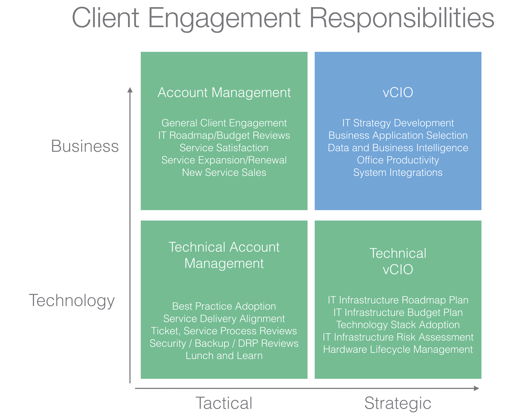
With respect to the four roles in your QBR there are communication agenda items for each:
What we are going to address here is which role and which agenda should be covered with the different types of clients and circumstances.
Walkthrough:
In this video we are going through the 3 steps that will find you the best template for your QBR.
- How to do a quick self assessment - now you know what approaches you might need
- How to choose from the three approaches - now you know what the different approaches do
- How to perform each approach - now you know what topics are covered and how
Step 1: Self Assessment
Not all QBRs are created equal. Each MSP has their own way to interact with clients based on their current situation.
To choose the right template for your QBR you must first assess your current situation to determine the best course of action.
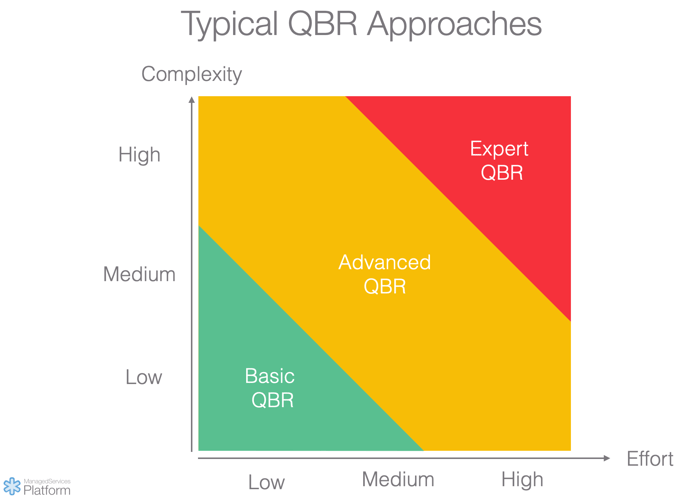
Assess the Complexity Scale
You should decide whether you have small, medium or high complexity in regard to QBRs.
We often see MSPs develop the wrong type of QBR process for their current complexity. When considering the complexity of your report, keep in mind how many people will be reviewing it and what roles they fill at your clients' offices. This will help you tailor the content to the appropriate audience for maximum relevant value.
Average Client Size
-
- Large client 75+ seats (high)
- Mid size client 25-75 seats (medium)
- Small client 25- seats (low)
The larger your clients are the more complex their business and IT environments can be. This requires assembling more complex reports delivered to different stakeholders.
Your Team Size:
-
- A Team delivers QBRs (high)
- A single Account Manager or vCIO delivers (medium)
- The MSP Owner delivers (low)
The bigger your team is the more communication, alignment and internal documentation is needed to stay productive.
Audience:
-
- Business Focus and Technical focus with multiple stakeholders (high)
- Mostly Business Focus with Executives (medium)
- Mostly Office Managers or IT Coordinators (low)
The more people involved throughout the QBR process the more alignment, communication and documentation is needed to get ideas and approvals across.
Decide the Complexity: High / Medium / Low
Considering your answers decide whether you need a Small / Medium or High Complexity approach.
Assess the Effort Scale
You should decide how much time you would like to allocate on the development and the maintenance of the QBRs. This helps to make sure that the process is conducted efficiently and won't be wasted effort.
We have seen small, less mature MSPs trying to jump too high on the maturity scale and then either not be able to develop the process they wanted or unequipped to sustain the QBRs.
Time for learning and implementation
-
- Less than 3 hours of initial implementation time (low effort)
- 3-7 hours of initial development time (medium effort)
- 7-10 hours of initial development time (high effort)
While it is possible to edit and customize the templates, we recommend you start by using the templates as provided. Once you've learned the basics, then, if you have the time and or resources, spend time on customization.
Preparing a client report:
-
- Less than 30 minutes per QBR (low effort)
- 1 hour per QBR (medium effort)
- Up to 2 hours per QBR (high effort)
The more time you can dedicate to a QBR the more widgets you can use and the more software functions you can leverage to generate more engaging processes with clients.
Maturity of the current processes:
-
- You have a current process in place with automation (low effort)
- You have a process but need better automation (medium effort)
- You do not have a current process / best practice (high effort)
The more mature your current QBR process the less time you need to develop your processes and deliver them.
Decide on the Effort: High / Medium / Low
Based on your answers decide whether you have a Small, Medium or High Effort approach.
2. Three Approaches of QBRs
Based on the Complexity / Effort scales, choose which template you'd like to start with.
The reports mentioned are additive, so you can start with a simpler approach then gradually add more components making your report more mature. You will not have to recreate existing reports as they can be updated as you go.
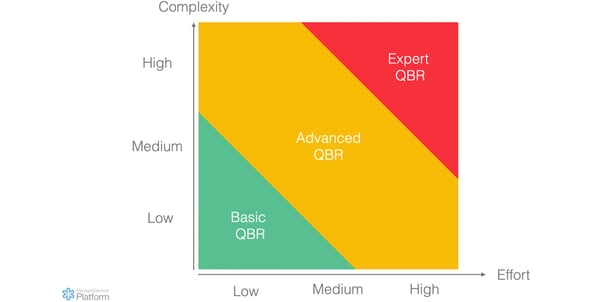
| Features Included in the Template | Basic | Advanced | Expert |
| Instructions | |||
| How to use the template | X | X | X |
| How to use the report tool | X | X | X |
| Change Log Checklist | - | X | X |
| Quarterly Business Review | |||
| Cover Page | X | X | X |
| Meeting Agenda | - | X | X |
| Strategy and Directions | |||
| Strategy Business Overview | - | X | X |
| What's New | - | X | X |
| Technology Landscape | - | X | X |
| Scorecard Summary | - | - | X |
| Technology Roadmap | |||
| Technology Health: Overview | X | X | X |
| Technology Health: Categories | X | X | X |
| Technology Roadmap | X | X | X |
| Technology Project Details | X | X | X |
| Technology Health: Detailed Assessment | X | X | X |
| Technology Operations | |||
| Technology Operations Tasks | - | - | X |
| Technology Operations Scorecard | - | - | X |
| Technology Operations Monthly Call Notes | - | - | X |
| Technology Operations Ticket Board | - | X | X |
| Technology Operations Critical Systems | - | X | X |
| Technology Operations Warranty Report | - | X | X |
| Technology Services | |||
| Technology Services Customer Satisfaction | - | X | X |
| Technology Services Reviews | - | - | X |
| Technology Services Team Scorecard | - | - | X |
| Client Scorecard | - | - | X |
| Technology Services Master Service Agreement | - | - | X |
| Technology Services Selector | - | - | X |
| Tools | |||
| Client Engagement Roles Explainer | - | X | X |
| Next QBR Scheduler | - | - | X |
| Cost of Downtime Calculator | - | - | X |
| Office Productivity Calculator | - | - | X |
| Return on Investment Calculator | - | - | X |
Basic QBR
If the effort is medium or low and the complexity is medium or low we suggest you use the Basic QBR.
The process uses a simple IT Infrastructure Audit with a generic MSP IT Infrastructure Health Assessment. It helps to quickly assess a client, prepare the report, farm projects and handle all tactical elements ad-hoc.
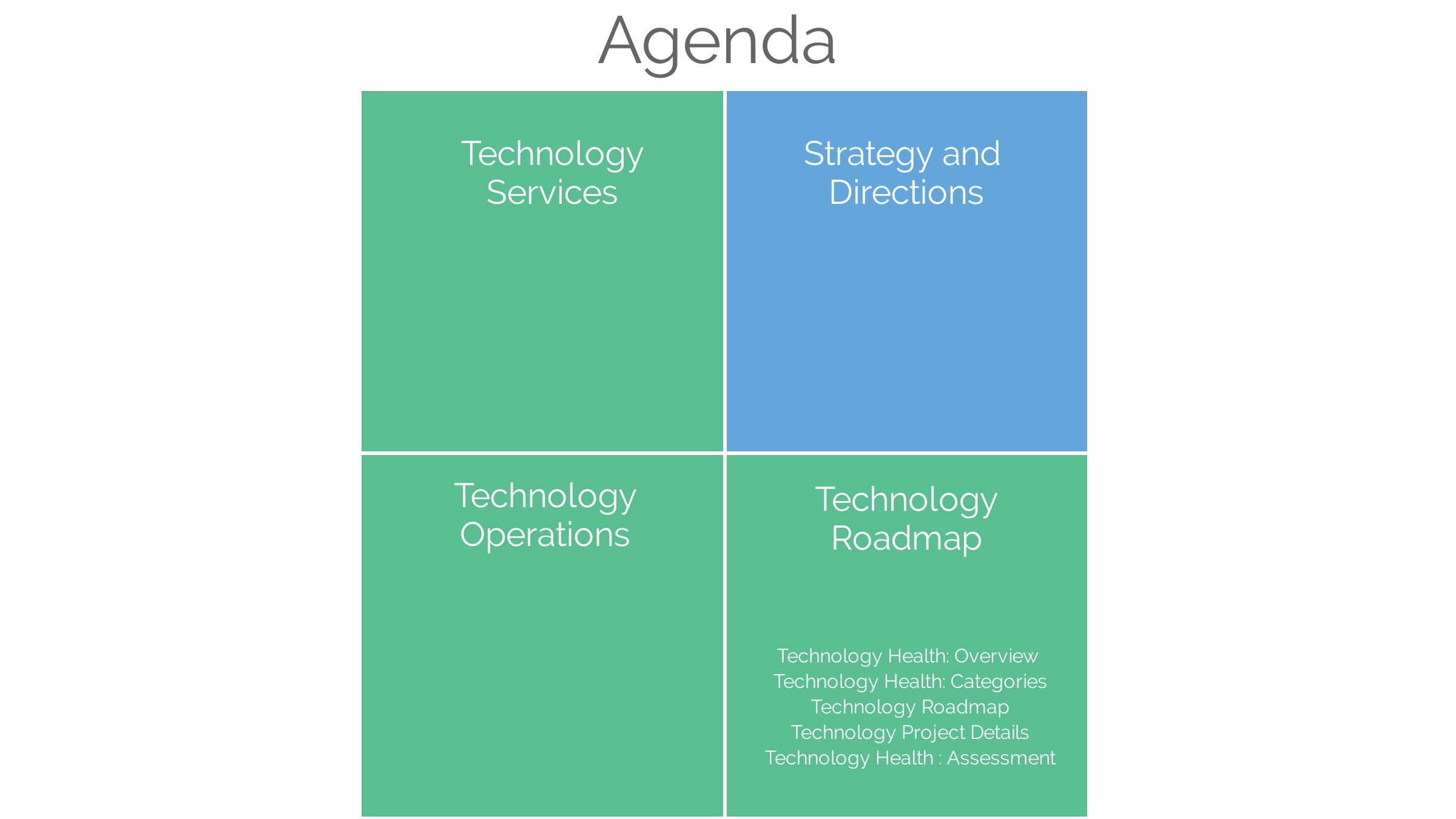
- Simple and ideal for ad-hoc meetings
- Very quick adoption time (2-3 hours)
- Great for technical related conversations
- Can be done irregularly once or twice a year
- Farming projects to a roadmap
- Very quick preparation time (~30 minute)
Advanced QBR
If both the effort and the complexity sit in the middle we suggest the QBR report template and simply removing or hiding most of the widgets.
The process uses more content widgets to make recurring meetings possible such as meeting agenda, executive overview, what's new, technology landscape and widgets with embedded technology reports such as Brightgauge.
This can leverage the tool's Snapshot feature to show progress over time.
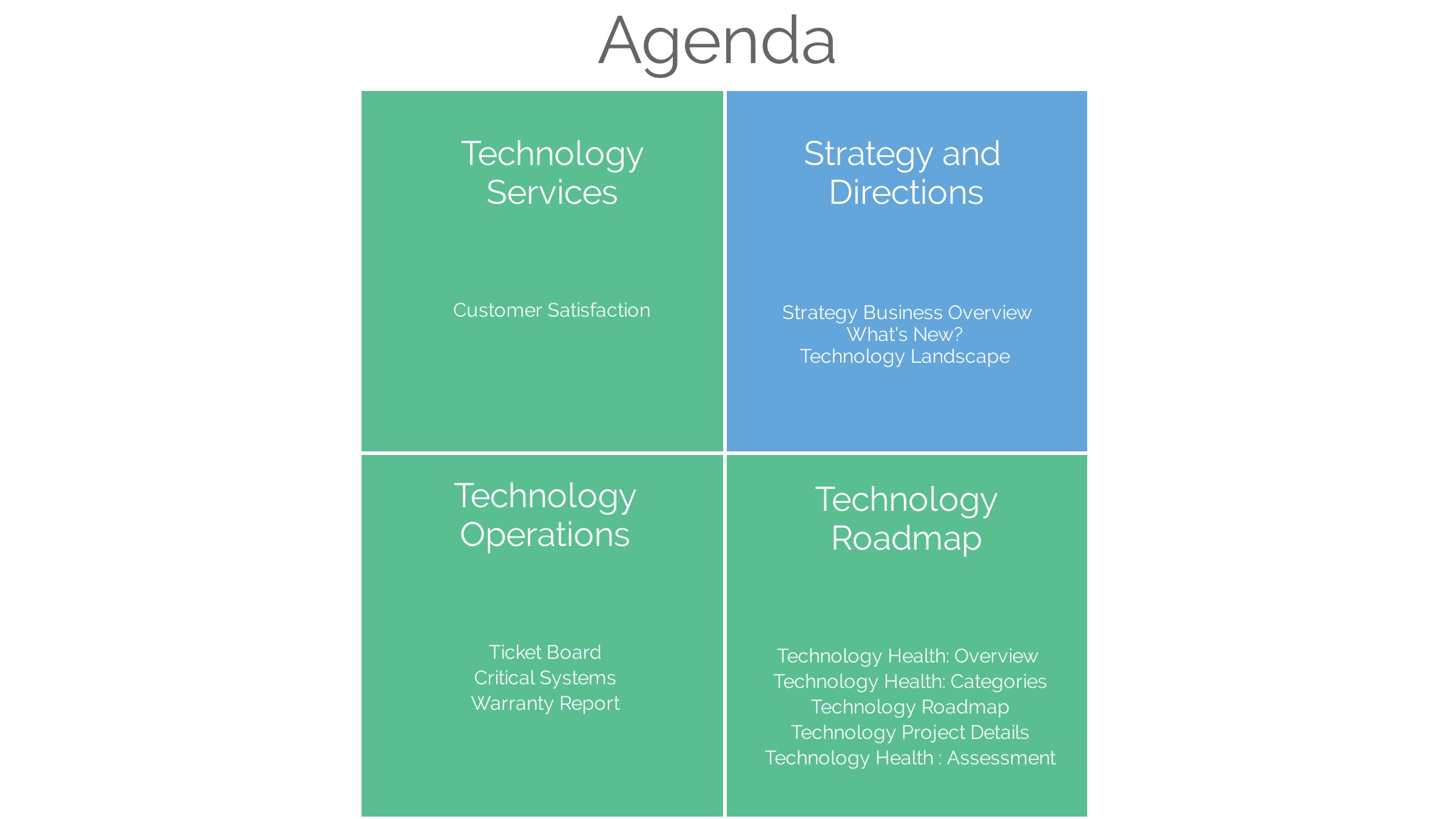
- Add a regular cadence
- Clarity on progress and value
- Accountability with logging the meetings
Expert QBR Approach
If your team is large and your clients are demanding or you are offering this process as a part of a paid engagement we suggest to go all-in. The modular report builder is going to give you many options and functions to use. Again, you can start small and add functions along the way.
Scorecards can be used for getting insights from internal resources, users or their executive team through simple questionnaires, and pushed into scorecards.
Service Review widget is a way that you can associate service bundles to your clients and review the offered services one-by-one. This is a great way to officially review your services with high maturity and demanding clients.
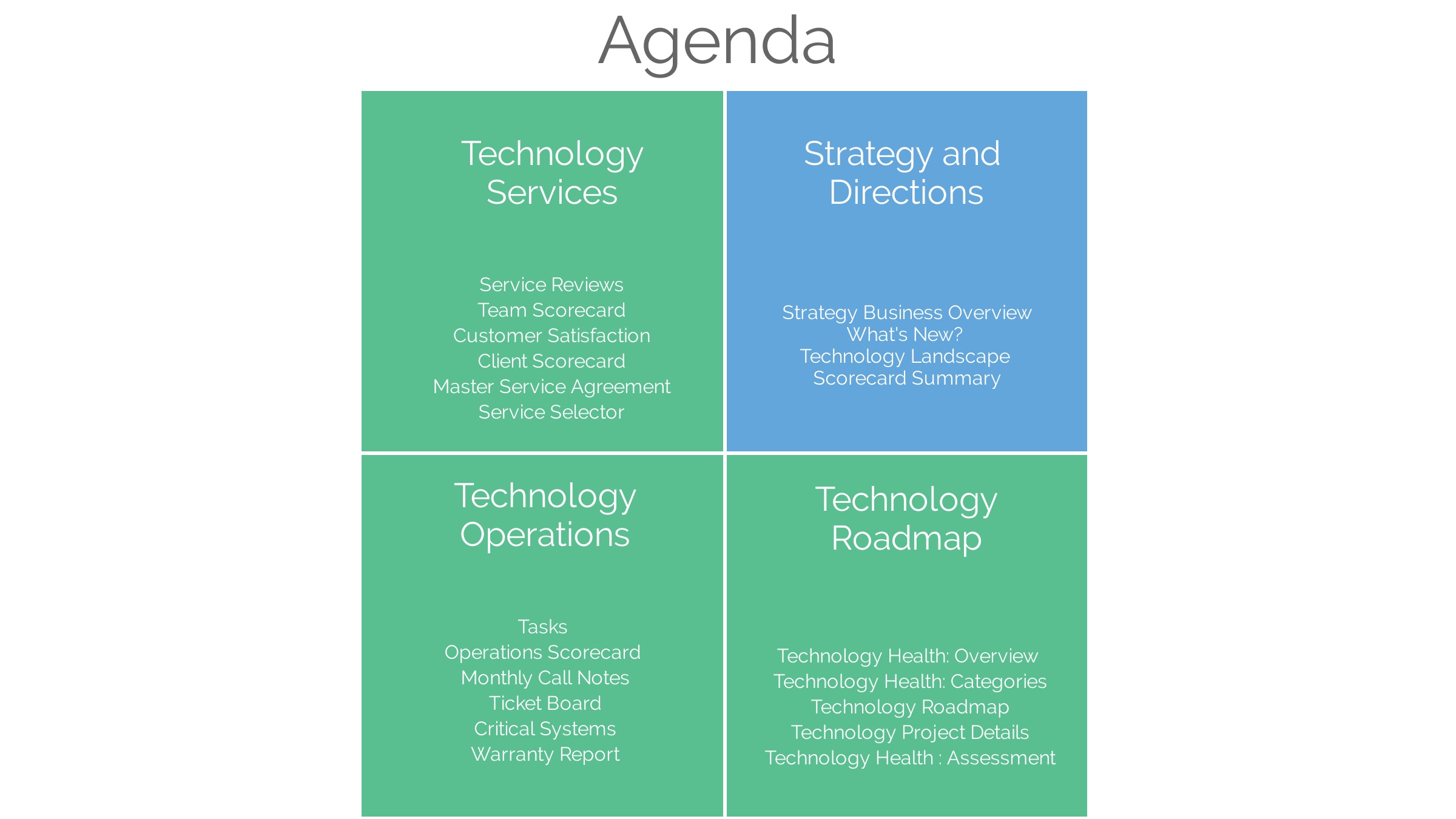
- Very versatile approach for handling very complex use cases
- Can be branded to your organization for use as an internal report (for internal IT teams)
- High level of PSA integrations allows you to develop very efficient workflows
- The report can be version controlled by an admin and lower permission users can only complete reports
- Combining with the Client Engagement Software overall Client Engagement Scores can be generated
Conclusion
Finding the right way to craft and effectively deliver your QBR requires the following:
- Understanding your Client Engagement roles
- Understanding the QBR agenda for each role
- Understanding what level of complexity in QBRs your clients require
- Understanding how much effort you can put behind a QBR
- Choice of an approach (or multiple if needed)
- Designing the agenda items
- Building a dynamic report that reflects the required outcomes
It might be intimidating but for Managed Services Clients you just need to go through the decision making process and pick our pre-built templates. Customize what you need but always consider the required time of development and delivery implications of those developments.



